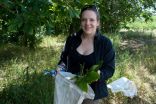(Press-News.org) Leaves of the European chestnut tree contain ingredients with the power to disarm dangerous staph bacteria without boosting its drug resistance, scientists have found.
PLOS ONE is publishing the study of a chestnut leaf extract, rich in ursene and oleanene derivatives, that blocks Staphlococcus aureus virulence and pathogenesis without detectable resistance.
The use of chestnut leaves in traditional folk remedies inspired the research, led by Cassandra Quave, an ethnobotanist at Emory University.
"We've identified a family of compounds from this plant that have an interesting medicinal mechanism," Quave says. "Rather than killing staph, this botanical extract works by taking away staph's weapons, essentially shutting off the ability of the bacteria to create toxins that cause tissue damage. In other words, it takes the teeth out of the bacteria's bite."
The discovery holds potential for new ways to both treat and prevent infections of methicillin-resistant S. aureus, or MRSA, without fueling the growing problem of drug-resistant pathogens.
Antibiotic-resistant bacteria annually cause at least two million illnesses and 23,000 deaths in the United States, according to the Centers for Disease Control and Prevention. MRSA infections lead to everything from mild skin irritations to fatalities. Evolving strains of this "super bug" bacterium pose threats to both hospital patients with compromised immune systems and young, healthy athletes and others who are in close physical contact.
"We've demonstrated in the lab that our extract disarms even the hyper-virulent MRSA strains capable of causing serious infections in healthy athletes," Quave says. "At the same time, the extract doesn't disturb the normal, healthy bacteria on human skin. It's all about restoring balance."
Quave, who researches the interactions of people and plants - a specialty known as ethnobotany - is on the faculty of Emory's Center for the Study of Human Health and Emory School of Medicine's Department of Dermatology. She became interested in ethnobotany as an undergraduate at Emory.
For years, she and her colleagues have researched the traditional remedies of rural people in Southern Italy and other parts of the Mediterranean. "I felt strongly that people who dismissed traditional healing plants as medicine because the plants don't kill a pathogen were not asking the right questions," she says. "What if these plants play some other role in fighting a disease?"
Hundreds of field interviews guided her to the European chestnut tree, Castanea sativa. "Local people and healers repeatedly told us how they would make a tea from the leaves of the chestnut tree and wash their skin with it to treat skin infections and inflammations," Quave says.
For the current study, Quave teamed up with Alexander Horswill, a microbiologist at the University of Iowa whose lab focuses on creating tools for use in drug discovery, such as glow-in-the-dark staph strains.
The researchers steeped chestnut leaves in solvents to extract their chemical ingredients. "You separate the complex mixture of chemicals found in the extract into smaller batches with fewer chemical ingredients, test the results, and keep honing in on the ingredients that are the most active," Quave explains. "It's a methodical process and takes a lot of hours at the bench. Emory undergraduates did much of the work to gain experience in chemical separation techniques."
The work produced an extract of 94 chemicals, of which ursene and oleanene based compounds are the most active.
Tests showed that this extract inhibits the ability of staph bacteria to communicate with one another, a process known as quorum sensing. MRSA uses this quorum-sensing signaling system to manufacture toxins and ramp up its virulence.
"We were able to trace out the pathways in the lab, showing how our botanical extract blocks quorum sensing and turns off toxin production entirely," Quave says. "Many pharmaceutical companies are working on the development of monoclonal antibodies that target just one toxin. This is more exciting because we've shown that with this extract, we can turn off an entire cascade responsible for producing a variety of different toxins."
A single dose of the extract, at 50 micrograms, cleared up MRSA skin lesions in lab mice, stopping tissue damage and red blood cell damage. The extract does not lose activity, or become resistant, even after two weeks of repeated exposure. And tests on human skin cells in a lab dish showed that the botanical extract does not harm the skin cells, or the normal skin micro-flora.
The Emory Office of Technology Transfer has filed a patent for the discovery of the unique properties of the botanical extract. The researchers are doing further testing on individual components of the extract to determine if they work best in combination or alone.
"We now have a mixture that works," Quave says. "Our goal is to further refine it into a simpler compound that would be eligible for FDA consideration as a therapeutic agent."
Potential uses include a preventative spray for football pads or other athletic equipment; preventative coatings for medical devices and products such as tampons that offer favorable environments for the growth of MRSA; and as a treatment for MRSA infections, perhaps in combination with antibiotics.
"It's easy to dismiss traditional remedies as old wives' tales, just because they don't attack and kill pathogens," Quave says. "But there are many more ways to help cure infections, and we need to focus on them in the era of drug-resistant bacteria."
INFORMATION:
The research was funded by the NIH National Center for Complementary and Integrative Health. In addition to Quave and Horswill, the study's authors include: Emory researchers James Lyles and Kate Nelson; and Jeffery Kavanaugh, Corey Parlet, Heidi Crosby and Kristopher Heilmann from the University of Iowa.
WASHINGTON (August 24, 2015) -- Obese atrial fibrillation patients have a lower chance of arrhythmia recurrence if they have high levels of cardiorespiratory fitness, and risk continues to decline as exercise capacity increases as part of treatment, according to a study published today in the Journal of the American College of Cardiology.
Cardiorespiratory fitness gain provides an incremental gain over weight loss in long-term freedom from arrhythmia.
"While weight loss is important for heart disease patients, especially those with arrhythmia, our study shows it's ...
DARIEN, IL - A new study clearly establishes a partial genetic basis underlying racial differences in slow-wave sleep, suggesting that it may be possible to develop sleep-related therapies that target specific genetic variants.
Using a panel of 1,698 ancestry informative genetic markers, the study found that greater African genetic ancestry was associated with lower amounts of slow-wave sleep in African-American adults. African ancestry explained 11 percent of the variation in slow-wave sleep after adjustment for potential confounders. Although a similar association was ...
Since its discovery, graphene has captured the attention of scientists and engineers for its many extraordinary properties. But graphene oxide -- an oxidized derivative of graphene -- largely has been viewed as graphene's inferior cousin.
"Graphene is so perfect," said Northwestern Engineering's Jiaxing Huang. "And graphene oxide is more defective, so it's like the weaker, less exciting version of graphene."
Now a Northwestern University team has found that graphene oxide's seemingly undesirable defects surprisingly give rise to exciting mechanical properties. Led by ...
From the spinning disc of a computer's hard drive to the varying current in a transformer, many technological devices work by merging electricity and magnetism. But the search to find a single material that combines both electric polarizations and magnetizations remains challenging.
This elusive class of materials is called multiferroics, which combine two or more primary ferroic properties. Northwestern University's James Rondinelli and his research team are interested in combining ferromagnetism and ferroelectricity, which rarely coexist in one material at room temperature.
"Researchers ...
A review of survey data from more than 300 obese people who participated in a federally funded weight loss clinical trial found that although the overall weight loss rates were modest, those who rated their primary care doctor's support as particularly helpful lost about twice as many pounds as those who didn't.
In a report on the study by Johns Hopkins researchers, published in the Aug. 21 issue of Patient Education and Counseling, the researchers say the findings could inform the development of weight loss programs that give primary care physicians a starring role.
Researchers ...
A recently-published study found that while internal bleeding may be uncommon as a result of taking blood thinners such as Xarelto® (rivaroxaban) and Eliquis® (apixaban), the normal coagulation tests physicians use to check for the side effect of bleeding may not be reliable.
The study, published online in Annals of Emergency Medicine, found that in cases reported to Poison Centers, the routine labs used to monitor for clotting factors, such as prothrombin time (PT), PTT or INR commonly ordered to help diagnose internal bleeding may be elevated in a minority of ...
Astronauts aboard the International Space Station captured an image of Hurricane Danny moving through the Central Atlantic Ocean. Satellite data indicates that Danny is a small Category 2 hurricane, in which hurricane-force winds only extend 15 miles from the eye.
A NASA GOES Project animation of visible and infrared imagery of Hurricane Danny was created at NASA's Goddard Space Flight Center in Greenbelt, Maryland to show the development and movement of the storm. The animation shows the eastern and central Atlantic Ocean from Aug. 18 to 21, 2015.
Forecaster Cangialosi ...
"Flocking" or "swarming" behavior is omnipresent in the living world, observed in birds, fish, and even bacteria. Strikingly similar collective action can also be seen in biomolecules within and between cells. Such self-organization processes are the basis of life - without them no living cell would exist - yet they are not well understood. New insights into how this action is coordinated at the biomolecular level are emerging from studies of a model system based on actin filaments. Experimental evidence proves the inadequacy of widely accepted explanations, according to ...
AMHERST, Mass. - Inspired by natural "snapping" systems like Venus flytrap leaves and hummingbird beaks, a team led by physicist Christian Santangelo at the University of Massachusetts Amherst has developed a way to use curved creases to give thin curved shells a fast, programmable snapping motion. The new technique avoids the need for complicated materials and fabrication methods when creating structures with fast dynamics.
The advance should help materials scientists and engineers who wish to design structures that can rapidly switch shape and properties, says Santangelo. ...
ANN ARBOR--People who have not found their perfect fit in a career can take heart: There is more than one way to attain passion for work.
Contrary to popular wisdom, a love-at first-sight experience is not necessary when evaluating a potential job, according to a new University of Michigan study.
"The good news is that we can choose to change our beliefs or strategies to cultivate passion gradually or seek compatibility from the outset, and be just as effective in the long run at achieving this coveted experience," said Patricia Chen, a doctoral psychology student and ...



